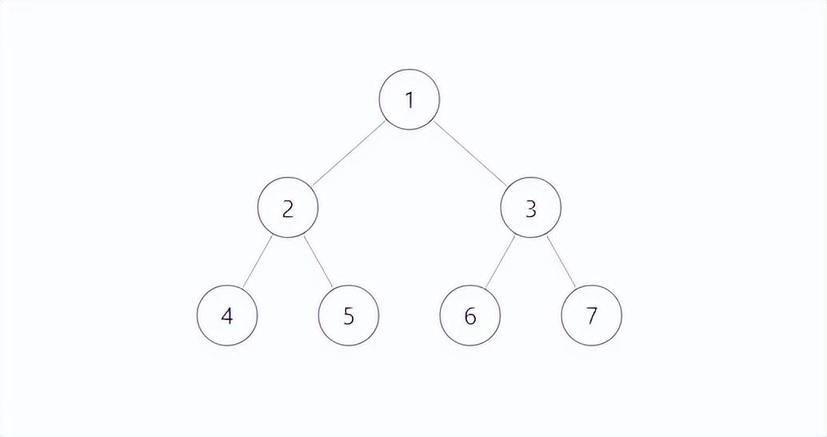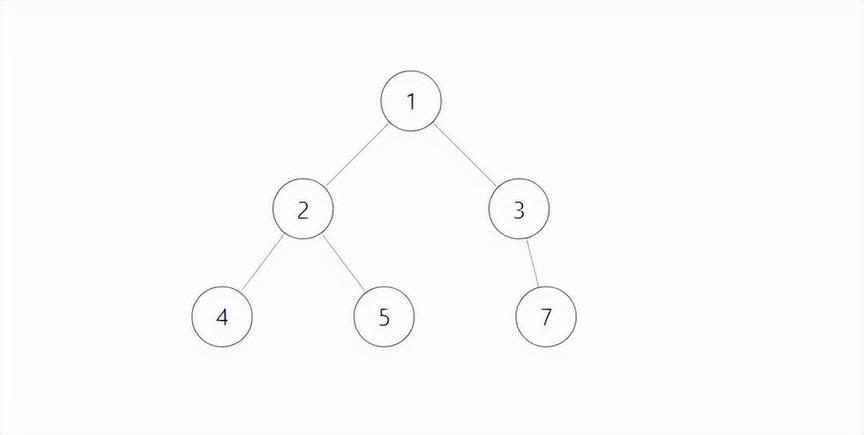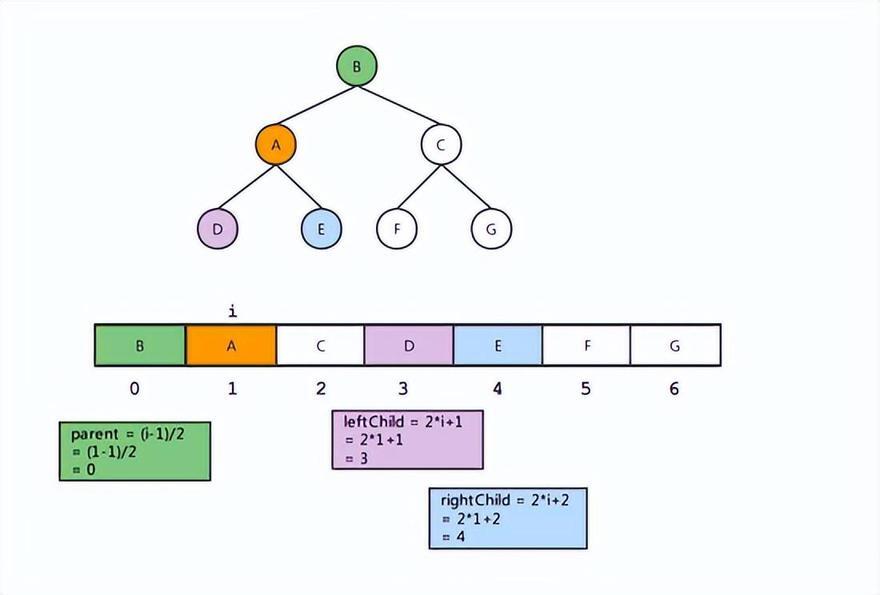大顶堆的实现(基于数组存储的完全二叉树)
- 2023-03-23 湖南
本文字数:3663 字
阅读完需:约 12 分钟
完全二叉树
完全二叉树的定义
满二叉树

非完全二叉树,非满二叉树

完全二叉树

完全二叉树的特点
叶子结点只能出现在最下层和次下层,且最下层的叶子结点集中在树的左部。
完全二叉树的实现
二叉链表:直观,但占用内存大。
数组:简洁,但拓展麻烦。
比较推荐使用数组存储,本文也将基于数组存储介绍大顶堆的实现。
基于数组存储的完全二叉树节点与数组下标的关系
假设完全二叉树的 节点 A 存储在数组中的下标为 i 则:
节点 A 的 父节点 存储在数组中的下标为 (i - 1) / 2
节点 A 的 电子节点 存储在数组中的下标为 2 * i + 1
节点 A 的 右子节点 存储在数组中的下标为 2 * i + 2

堆
堆的定义
堆是一种特殊的数据结构,是高效的优先级队列,堆通常可以被看做一棵完全二叉树。
堆的分类
根据堆的特点,可以把堆分为两类:
大顶堆:每一个节点的值都大于或等于其左右子节点的值。
小顶堆:每一个节点的值都小于或等于其左右子节点的值。
堆的插入
往堆中插入数据,可能会破坏大顶堆(小顶堆)的性质,需要对堆进行调整。
堆的插入流程如下:
将插入的数据置于数组的尾部
将新插入的节点作为当前节点,比较当前节点与其父节点是否满足堆的性质,不满足则交换
重复步骤 2,直到满足堆的性质或者当前节点到达堆顶。
/** * 添加元素 * @param value 待添加元素 */public void offer(int value){ if(this.currentLength >= this.capacity){ // 数组已耗尽,扩增数组为原来的两倍 this.grow(); } int cur = this.currentLength++; // 获得待添加元素的添加位置 if(cur == 0){ // 当前堆为空直接添加 this.tree[cur] = value; }else{ // 当前堆不为空,添加之后要向上调整 this.tree[cur] = value; // 步骤 1 int p = cur; int parent = this.getParentIndex(p); while(this.tree[parent] < this.tree[p]){ // 步骤 2 this.swap(parent, p); p = parent; parent = this.getParentIndex(p); } }}往堆中插入数据的时间复杂度为 O(logN)
堆的构建
构建一个大小为 N 地堆,其实就是执行 N 次插入。
所以构建一个大小为 N 的堆,其时间复杂度为 O(NlogN)
堆的删除
堆的删除也可能会破坏大顶堆(小顶堆)的性质,需要对堆进行调整。
堆的删除流程如下:
取出堆顶的数据
用堆的最后一个元素代替堆顶元素
判断当前节点(一开始是堆顶),是否满足大顶堆(小顶堆)的性质,不满足则用左右子节点中较大的节点进行交换
重复步骤 3 直到满足堆的性质或没有子节点
/** * 取出最大元素 * @return 最大元素 */public int poll(){ if(isEmpty()){ throw new RuntimeException("堆为空,无法取出更多元素!"); } int cur = --this.currentLength; // 获得当前堆尾 int result = this.tree[0]; // 取出最大元素 步骤1 this.tree[0] = this.tree[cur]; // 将堆尾移到堆头 步骤2 if(cur != 0){ // 如果取出的不是最后一个元素,需要向下调整堆 步骤3 int p = 0; int left = getLeftIndex(p); int right = getRightIndex(p); // 由于是数组实现,数组元素无法擦除,需要通过边界进行判断堆的范围 // 当前节点和左节点在堆的范围内, while(p < this.currentLength && 0 <= left && left < this.currentLength && (this.tree[left] > this.tree[p] || this.tree[right] > this.tree[p])){ if(right >= this.currentLength){ // 当前节点没有右节点 if(this.tree[left] > this.tree[p] ){ // 左节点大于当前节点 swap(p, left); p = left; } }else{ // 两个节点都在堆范围 if(this.tree[left] > this.tree[right]){ // 用大的节点替换 swap(p, left); p = left; }else{ swap(p, right); p = right; } } left = getLeftIndex(p); right = getRightIndex(p); } } return result;}堆的删除元素时间复杂度为 O(logN)
完整代码
// 大顶堆public class Heap { private int[] tree; // 数组实现的完全二叉树 private int capacity; // 容量 private int currentLength; // 当前数组已使用长度
/** * 构造函数 * @param capacity 初始容量 */ public Heap(int capacity) { this.tree = new int[capacity]; this.capacity = capacity; this.currentLength = 0; }
/** * 添加元素 * @param value 待添加元素 */ public void offer(int value){ if(this.currentLength >= this.capacity){ // 数组已耗尽,扩增数组为原来的两倍 this.grow(); } int cur = this.currentLength++; // 获得待添加元素的添加位置 if(cur == 0){ // 当前堆为空直接添加 this.tree[cur] = value; }else{ // 当前堆不为空,添加之后要向上调整 this.tree[cur] = value; // 步骤 1 int p = cur; int parent = this.getParentIndex(p); while(this.tree[parent] < this.tree[p]){ // 步骤 2 this.swap(parent, p); p = parent; parent = this.getParentIndex(p); } } }
/** * 取出最大元素 * @return 最大元素 */ public int poll(){ if(isEmpty()){ throw new RuntimeException("堆为空,无法取出更多元素!"); } int cur = --this.currentLength; // 获得当前堆尾 int result = this.tree[0]; // 取出最大元素 步骤1 this.tree[0] = this.tree[cur]; // 将堆尾移到堆头 步骤2 if(cur != 0){ // 如果取出的不是最后一个元素,需要向下调整堆 步骤3 int p = 0; int left = getLeftIndex(p); int right = getRightIndex(p); // 由于是数组实现,数组元素无法擦除,需要通过边界进行判断堆的范围 // 当前节点和左节点在堆的范围内, while(p < this.currentLength && 0 <= left && left < this.currentLength && (this.tree[left] > this.tree[p] || this.tree[right] > this.tree[p])){ if(right >= this.currentLength){ // 当前节点没有右节点 if(this.tree[left] > this.tree[p] ){ // 左节点大于当前节点 swap(p, left); p = left; } }else{ // 两个节点都在堆范围 if(this.tree[left] > this.tree[right]){ // 用大的节点替换 swap(p, left); p = left; }else{ swap(p, right); p = right; } } left = getLeftIndex(p); right = getRightIndex(p); } } return result; }
public boolean isEmpty(){ return this.currentLength <= 0; }
private int getParentIndex(int index){ return (index - 1) / 2; }
private int getLeftIndex(int index){ return 2 * index + 1; }
private int getRightIndex(int index){ return 2 * index + 2; }
private void swap(int left, int right){ int temp = this.tree[left]; this.tree[left] = this.tree[right]; this.tree[right] = temp; }
/** * 将数组拓展为原来的两倍 */ private void grow(){ this.tree = Arrays.copyOf(this.tree, 2 * currentLength); this.capacity = this.tree.length; }}
Java你猿哥
一只在编程路上渐行渐远的程序猿 2023-03-09 加入
关注我,了解更多Java、架构、Spring等知识











评论